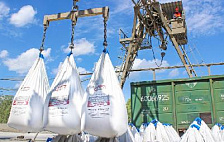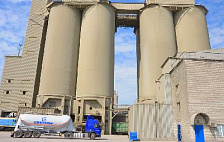The Portland Cement Association offered a glimpse at the roadmap which it plans to develop to help its members achieve carbon neutrality by 2050. PCA first announced plans to develop a roadmap November 2020. The roadmap is to be approved by PCA board by the end of 2021.
“As PCA members continue to drive down the carbon intensity of their operations and products, PCA will dev roadmap by end of 2021 to facilitate its member companies in achieving carbon neutrality across the concrete value chain by 2050,” said Mike Ireland, PCA President & CEO.
“Carbon neutrality will be here by 2050,” Rick Bohan, PCA’s vice president of sustainability, told the press in June. “There’s no doubt about it.”
In fact, Bohan said the industry could meet those goals sooner, depending on how much help it has.
Bohan noted two particular areas for carbon reduction: Direct reductions, which can be accomplished through portion control, reducing the amount of cement used to produce materials at that stage; and avoidance, which eliminates CO2 emissions from ever occurring.
PCA’s roadmap includes steps that can be done today—and they’re not pie in the sky, they’re just not widely adopted or practiced. These include optimization of methods, materials, and delivery.
Here are a few examples:- Optimizing Clinker: With clinked production more than 60% of the CO2 comes from the chemical reaction, and that requires high temperatures through combustion, which accounts for the other 40%. So plants need to use materials that are already processed like fly ash and slag, which reduces the chemical factor, while looking to alternatives fossil fuels.
-
Optimizing Cement: Optimizing cement will come from using less clinker, replacing it with materials like fly ash and slag, as well as by increasing brown limestone. Acceptance for Portland limestone cements is growing; it’s been around for decades, including in France since ’60s, and 35 state DOTs in the U.S. recognize it. Optimizing cement also will come from new innovative technologies, which all manufacturers are already working on. Zero-emissions transportation, such as battery-powered trucks and a shift for rail carriers from diesel-electric locomotives to electric locomotives, will be critical to achieving these goals, as well.
-
Optimizing Concrete: Optimizing concrete will including tackling the materials that go into it, through the use of materials like fly ash, slag, limestone, chemical admixtures, and mineral admixtures, and through the use of machine learning and AI to ensure the right mix for the right application. In addition, plants are shifting to renewable power and using breakthrough technologies.
-
Optimizing Construction: Carbon neutrality won’t just rely on changes to material production, but also how it’s used. Design tools including 3D modeling and virtual reality will help to optimize materials specification. Zero-waste construction, already practiced in Europe, will be crucial, along with sequencing, scheduling, zero-emission delivery, and materials handling.
-
End of Life: Finally, there needs to be recognition of concrete’s role as a carbon sink—10% of CO2 generated in production in absorbed through the life of the concrete structure, Bohan noted. Demolition creates more surfaces to absorb CO2.
While PCA recognizes the vital role concrete producers and users play in emissions reduction, “We can’t do this alone,” Bohan noted. “This is not just the cement industry that’s involved. It’s everyone that is involved throughout the value chain,” from those driving raw materials to the people who occupy the buildings.








